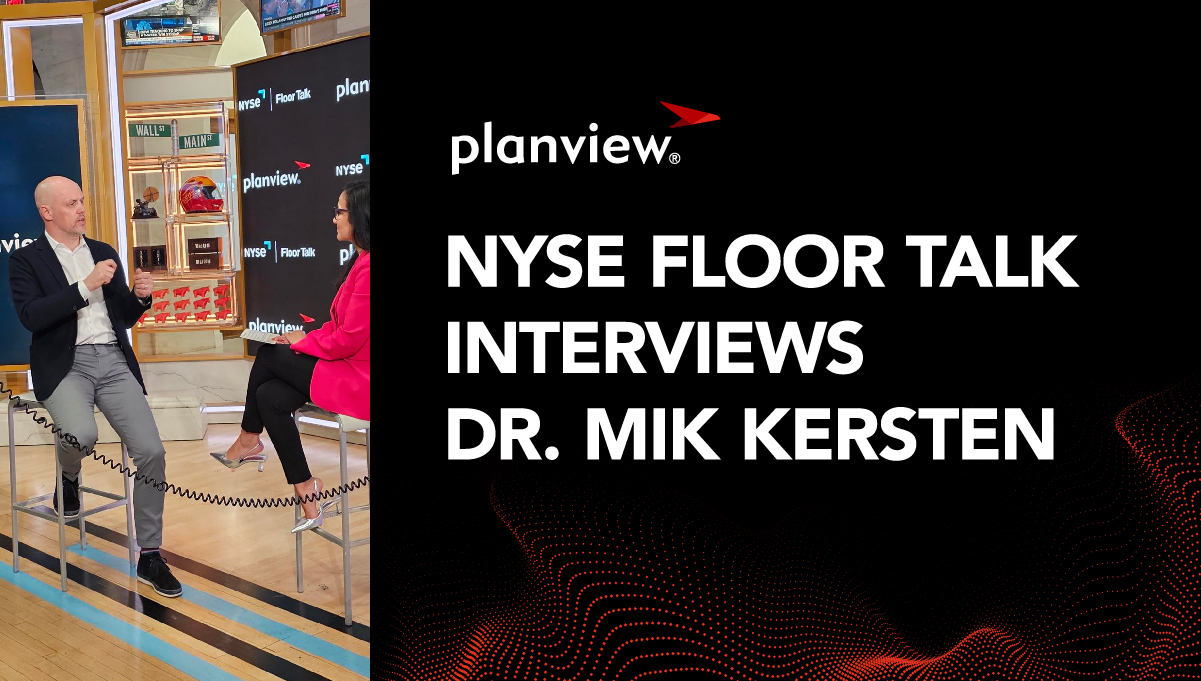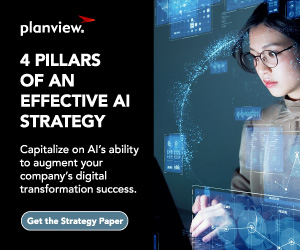
Pallab Chatterjee, Ph.D., is an internationally recognized high-tech executive with decades of experience in corporate general management, governance, strategy, technology, and operations. Dr. Chatterjee Is currently chairman of 3 Lines VC, a boutique venture capitalist firm specializing in investments in AI-focused companies in the US and India. He also serves as a Planview Executive Advisor.
Just a few years ago, AI was a buzzword – an interesting technology on the back burner of IT departments. But with the emergence of generative AI and ChatGPT, all that changed. Suddenly, CEOs need to answer three key questions:
- What is your AI strategy?
- How will you leverage generative AI as a competitive advantage?
- How will your company balance current business initiatives with AI development?
The C-suite has to identify, adopt, and express a strategic approach to the AI paradigm we all have entered, and provide a blueprint for how their organizations will compete and thrive in it.
AI Is Now a Corporate Imperative
AI can augment your employees’ efforts, increase productivity, and assume many mundane tasks that reduce employee engagement. These improvements are powerful. AI-driven technologies that allow us to work smarter, better, and faster can result in productivity that’s 10 to 20 times higher.
Productivity is just the tip of the iceberg. As companies build out their own digital operating models and AI Factories, the benefits of AI will be too massive to ignore.
AI is coming with greater force and speed than most realize. It will require investment and substantial changes in the way we structure and operate our businesses. And the earlier your organization embraces it, the more you stand to gain.
The Rise of Digital Operating Models
In their book Competing in the Age of AI, Harvard professors Marco Iansiti and Karim Lakhani illustrated how AI-centric organizations exhibit a new operating architecture, redefining how they create, capture, share, and deliver value.
They introduced two novel concepts: The “digital operating model” and the “AI Factory.” Their goal was to design digital operating models that would use algorithms to do many of the tasks currently done by human labor. While their models stopped short of what’s now available via generative AI, the two concepts remain prescient.
Today’s digital operating models aim to examine corporate business processes to assist, enhance, or replace labor with algorithms. They allow corporations to scale their business, increase the scope of that business, and identify new opportunities—all with minimal increases in labor costs as compared to traditional operating models.
Those who fail to implement digital operating models will face huge competitive challenges.
Amazon in retail, Uber in transportation, and ANT Financial in banking are examples of companies that have leveraged the digital operating model to grow exponentially.
Digital Operating Models Defeat the Competition
Long before the emergence of AI, digitization was making waves across the business spectrum. Consider ANT Financial. Founded in 2014, ANT was built on modern digital operating policies and technologies. No “transformation” was required. Today, ANT is a $1.3T bank with 750 million customers and 9,000 employees.
Contrast that with Bank of America, a much older institution that’s been undergoing a digital transformation for two decades. Today, it’s a $2T bank with 50 million customers and 166,000 employees.
ANT serves 15 times the customers with just five percent of the employees. If you want to understand the value of a digital operating model, look no further.
What a Digital Operating Model Can Do for You
Organizations that implement a digital operating model stand to gain significant competitive advantages, including:
- Driving growth and increasing revenue within the scope of your current business.
- Scaling your business without significantly increasing the number of employees.
- Identifying, evaluating, and analyzing aligned or adjacent opportunities to increase the breadth of your current offerings.
- Prioritizing those opportunities in terms of which will deliver the greatest value.
As the ANT example shows, a digital operating model cannot be achieved through incremental digitization. This model requires a structural overhaul that transforms the work being done in your organization into digital tasks that can be entirely automated or significantly enhanced with AI. This is a key component in the creation of an AI Factory.
The AI Factory: The Digital Operating Model’s Engine
We typically think of factories as facilities that mass produce at speed the products we use. Similarly, the AI Factory leverages data, people, process, product, and platform to provide AI solutions for business at speed. The AI Factory is fueled by a corporate data layer upon which algorithms capable of transforming business processes are built.
Over time, just as factories increase automation and introduce efficiencies to enhance and streamline operations, so will the AI Factory. And just as manufacturing factories transformed artisan work to blue-collar work during the Industrial Revolution, so will the AI factory transform white-collar work.
The AI Factory is not a subset of the digital transformation. It’s a leapfrog over it that will actually achieve the promised benefits of digitization.
Because instead of incrementally piecemealing a digital transformation together, the AI Factory runs an overarching digital operating model that will deliver results far more consistently and rapidly.
This will enable traditional companies that were struggling with their digital transformations to remodel themselves into highly competitive organizations. This could be a last, best chance to catch up to companies like Amazon.
Amazon led the way through the first round of the digital operating model, allowing them to expand across different categories and create new offerings like Amazon Web Services (AWS), the Amazon cloud, and Alexa, all built on Amazon’s AI platform.
And Amazon is just getting started. With the development of their own proprietary large language model undoubtedly underway, they’ll be more connected, discover more opportunities for growth, and create even greater distances between themselves and competitors.
A Corporate Large Language Model (LLM)
A key consideration in forming an AI Factory is that companies must use their own internal data as the base data layer.
Today’s generative AI is built on LLMs that leverage the vast amounts of data available on the web. It’s a relatively simple process since web data is standardized in HTTP and HTML formats that allow models to be created efficiently.
But in modern enterprises, corporate data is much more complex: relational databases, data schemas, taxonomies, as well as industry-specific vocabulary and semantics are unique to each corporation, and that uniqueness is built into legacy IT applications.
These complexities make the data difficult to access, interpret, analyze, and ultimately leverage for the purposes of AI. In short, existing web LLMs are unable to support corporate AI Factories. The next frontier is a corporate LLM that integrates all the information and activities inside each organization.
Customizing a Corporate LLM
For companies to fully leverage AI in the near term, they must create their own internal LLM that uses their own semantics, language, and data upon which AI models can be generated. Currently, that’s the only way to unleash the true power of generative AI.
Technology firms are racing to create LLMs for a variety of use cases. And there is an opportunity to build generic, industry-based models, like an LLM for the automotive industry. However:
- These models are not yet available and may not be for some time.
- They will need to be enhanced and customized for each specific company and the state of that company’s data.
- When they do become available, competitors will have equal access.
The problem is that CEOs aren’t being asked how they will embrace AI two years from now. While the window of opportunity is enormous, boards recognize that it will close rapidly as early movers leave competitors behind.
The answer is to build an LLM capable of leveraging the full power of your corporate data and over which a digital operating model can be implemented. Together, these will act as the fuel and the engine for your generative AI factory.
The AI Factory Buildout
The creation of an AI Factory will be a multi-faceted process:
- Declare AI as a strategic imperative.
- Ensure your data scientists are actively gaining the expertise they’ll need.
- Build a proprietary large language model.
- Design multiple algorithms and models focused on various roles, starting with the most obvious candidates for AI enhancement.
- Transform your traditional operating model into a digital operating model.
- Test and experiment before moving anything into production.
- Continuously reevaluate how you’re investing your resources through the transformation.
You will have to make some tough choices, including defunding current software projects and redirecting those development dollars toward your AI model buildout. Some short-term pain may be required for long-term prosperity. A portfolio analysis will help to ease the pain and ensure your desired outcome by:
- Ascertaining where your investment is best spent to make you competitive.
- Measuring the difference between continuing along your current path or reassigning funds towards the development of an AI model.
- Evaluating how reassigning resources will impact current projects and company revenues and profitability.
You must be able to weigh the benefits of creating an AI Factory versus continuing with incremental projects currently underway.
How Planview Can Help
The C-Suite has a decision to make. Form a strategic imperative to move your organization into the Age of AI or continue with a traditional operating model and hope for the best.
If you choose the former, you will need to rethink your current portfolio, reevaluate your existing investment strategy, reassign your resources, and reprioritize your approach to the market.
A strategic portfolio management (SPM) solution can help you achieve the delicate balance between preparing for the coming AI tsunami and continuing to support your existing portfolio. Learn how Planview’s SPM solution enables you to realize strategic objectives at speed.







